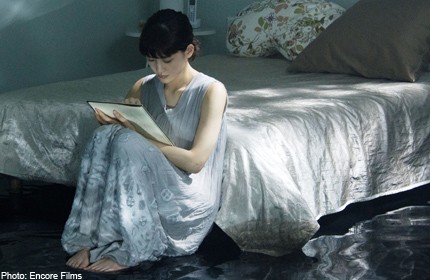Man interacts with comatose lover through medical procedure

Japanese director Kiyoshi Kurosawa once said in an interview that with every film he makes, it is his wife's approval that he is trying to win.
So what does she make of his latest film, Real? In it, a man interacts with his comatose lover through a medical procedure called "sensing". The movie opens in cinemas today.
Speaking over Skype from Japan, a genial Kurosawa, 58, says in Japanese through an interpreter: "She's very happy with it. But I'm wondering which interview you read that in since it probably would not be well-known in Singapore."
For the record, it was an interview posted on twitchfilm.com in December 2008.
Asked for more details about her, he says: "She is my manager and her name is Hiromi. I think it's the first time I'm actually saying it in an interview, so it's weird to say it out loud."
His wife is 59 and the couple have no children.
Even though the two clearly have a close relationship, Kurosawa draws the line at entering her subconscious, if the technology depicted in his film were possible.
He says: "It would be a scary thing to find out what people close to you are thinking about you and it's better not to know. "Instead, I would be curious to find out what people who live in different environments, say, in Africa, think about my movies."
He might well find fans of his work even in far-off Africa. Kurosawa is best known for his horror films including Pulse (2001), about ghosts using the Internet as a portal to invade the world of the living, and Retribution (2006), about a detective's investigation into a string of murders.
His last film, Tokyo Sonata (2008), was a dark family drama and marked a departure of sorts for him. It won the award for Best Film at the 3rd Asian Film Awards and the Prix Un Certain Regard at Cannes Film Festival.
Real was released in Japan in June. It was also shown at the Toronto International Film Festival and New York Film Festival to mixed reaction. Takeru Satoh, recently seen in anime adaptation Rurouni Kenshin (2012), and Haruka Ayase, still remembered for her turn in the TV romance tragedy Socrates In Love (2004), star.
The film continues Kurosawa's trajectory away from horror as it ventures into science-fiction territory.
It also featured the heavy use of CGI when it came to portraying a plesiosaur, a pivotal creature in the film.
Kurosawa notes: "It was difficult to shoot because you couldn't see the creature while filming, but it was very interesting and enjoyable to do this.
"While movies have been made about dinosaurs as far back as a hundred years ago, the advent of technology means that they can be depicted with a greater degree of realism than ever before."
Horror fans can take heart though.
He says: "I don't to plan to leave horror totally, but I also don't want to just make horror films.
"Ninety-nine per cent of my films might seem realistic, but I want to inject 1 per cent of non-realistic elements into them, and it could be anything from a sense of horror to comedy."
While it took five years for him to make another film after Tokyo Sonata, Kurosawa has not been resting on his laurels.
He completed three scripts and is now working on another three to four. He has a project lined up for next spring, but details are still under wraps.
This much he can reveal: "Alas, it's not horror, but there may be elements of the supernatural in it, and that's very much my style."

Get a copy of The Straits Times or go to straitstimes.com for more stories.